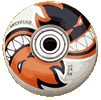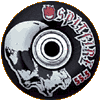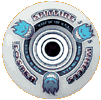Bearings: A Smooth Ride Inside
The Science and Art of Skateboard Design (continued...)

Though Cadillac Wheels had revolutionized skateboarding with the smooth sure ride of urethane, they still had one big flaw: the bearings. Like all the earlier skateboard and roller skate wheels, the Cadillac had simple ball bearings, which were exposed and easily contaminated by sand and grit from the road. These wheels rolled poorly, often roughly, and the bearings wore out quickly. The advent of precision sealed circular bearings changed all of that, as Piumarta relates:
"The gold star (in wheel design) would go to Frank Nasworthy who developed the Cadillac wheel back in1972 or 1973. But he developed a wheel with the old drop in ball bearings like your mom and dad's roller skates. About 1974 the owner of our company, Richard Novak, came up with a design where he could introduce an old Hoover vacuum cleaner bearing on either side of the wheel. And he put two on either side of the truck axle, and really this changed skateboarding...because once the wheels got the bearings in them, they could go much faster, and we could put a lot more technology into the wheel itself. It was the Road Rider wheel, back in 1974-75, putting those sealed bearings into each side of the wheel meant that wheels lasted longer, they could go faster, and it really helped to develop roller sports from that point on." The combined effect of urethane wheels and precision bearings transformed skateboards from a clunky, skittery plank into an amazingly effective urban conveyance, smooth and sure-footed.



Once these innovations were in place, skateboard wheels have remained pretty much the same. . Small differences in wheel size, shape, and hardness are chosen based on the type of skating a rider wants to do. Asked what makes a really good wheel, Piumarta said, "The shapes don't matter much. Really it's the raw materials. Speed is everything, and to me rebound means speed, even at the high durometer. Generally, size doesn't make much difference. The larger wheels are best for vert riding, anywhere up to the 66-millimeter range. Street skating wheels are generally 51 mm to about 57 mm."
Tim Piumarta believes that the care and skill with which a wheel is manufactured makes the difference between a good wheel and a bad one, "The best way to make wheels is to use really expensive 2-3 part urethanes which are open-cast-poured into moulds. I'll equate skateboard wheels to baking in a kitchen: you have eggs, flour and milk. Depending on your skills, you will get either biscuits, or a soufflé. That has a lot to do with skateboard wheels today. Anyone can buy the raw materials; those are easy to get. It's the techniques, the tools, and the philosophy of making the wheel that will determine whether you get a biscuit of a wheel or a soufflé."
